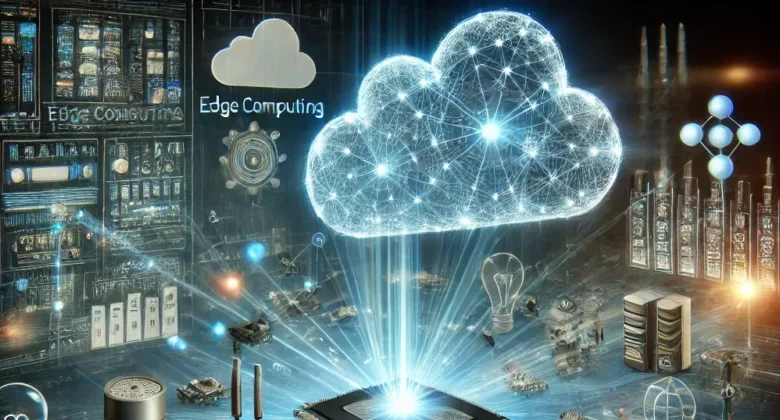The Rise of Edge Computing and Its Implications forIoT Devices

The complexity and scale of data produced and processed daily have pushed the limits of technology. Experts are now moving towards edge computing to ensure faster data processing, reduced latency, and smoother application running. This new phenomenon allows enterprises, from healthcare to entertainment, that heavily lean on IoT devices for their day-to-day operations to improve efficiency, prevent go-slows, and improve user experience.
What is Edge Computing?
Edge computing is a computing model that transmits and processes data at the periphery of the network as close to the source as possible. It differs from traditional cloud computing in that data doesn’t go to a central server for processing; instead, it works on a distributed model.
Edge computing has several advantages.
Reduced latency: Edge computing optimizes computers by reducing the distance between the data source and the server. By processing data closer to the source, computing takes less time and thus has lower latency.
Improved data processing speeds: Since the processing occurs in a nearby server, edge computing
enhances real-time processing, consequently generating better data processing speeds. Also, distributing the workload to peripheral servers reduces the workload on congested central servers and improves speed.
Enhanced security for IoT devices: Edge computing uses a decentralized approach and eliminates the need for a central server. As such, even if cybercriminals infiltrate one server, they do not have access to all the data. Furthermore, keeping data processing in a controlled environment reduces the risk of unauthorized interception.
Cost-effectiveness for enterprises: Edge computing is highly cost-effective for data processing since it uses lower bandwidth and reduces network use. Furthermore, users require less cloud storage since data can be stored locally on the device.
Enhanced scalability: Edge computing prevents network congestion and reduces latency, which ensures that networks can easily handle large and small amounts of data as needed.
Better reliability: Edge computing ensures that IoT sensors communicate better with each other, reducing the chances of poor data transmission, which could cause system failure or slowing down. This, in turn, reduces hazards and enhances efficiency.
The Growth of IoT and the Need for Edge Computing
Thanks to an increase in computer device manufacturing, lower chip costs, and an increase in wireless networks, the number of IoT devices has increased exponentially. There are now all sorts of applications in utilities (smart meters), home security (intruder detection), building automation (automated lights and climate control), and healthcare (patient vital monitoring devices). As the number of available devices grows, so do the limits of cloud computing. All these connected devices have to transmit data to one another, and doing so through central servers congests current internet hardware.
Edge computing reduces the reliance on central servers and ensures data processing in real-time for better scalability, reliability, automated updates, and disaster prevention.
Implications for Various Industries
Healthcare: Edge computing ensures equity in healthcare through IoT devices. Patients and doctors benefit from real-time information processing, which enhances the information capital available for analysis. Edge computing reduces the dependency on central servers, increasing the speed of data processing and the privacy of digital health data.
Manufacturing: With lower latency and faster data processing speeds, industrial IoT devices work faster, which means less downtime and improved worker safety. IoT devices are also better equipped with real time monitoring, which means better breakdown prediction and proactive preventative maintenance.
Entertainment and Gaming: By processing data closer to where it’s consumed, edge computing ensures better real-time interaction and responsiveness, which are vital to the user experience in online gaming. Users also enjoy better streaming services and high-quality videos without interruptions. Platforms like Sloto Cash can now offer enhanced real-time gameplay for their users worldwide.
Retail: In the retail sector, edge computing ensures better-personalized customer experiences. Retailers can better analyze consumers from in-store sensors and harvest real-time consumer habits for their behavior studies. This information can be used to adjust marketing strategies, optimize inventory, and enhance the overall shopping experience in shorter bursts.
Enhanced Security for IoT Devices with Edge Computing
Security has always been a vital concern for IoT devices, and with the rapid increase in their use across industries, security threats have become more important. IoT devices have extensive connectivity and data exchange capacities, which increases the surfaces for cyberattacks.
As earlier stated, edge computing ensures computation and data storage closer to the devices that produce the data instead of relying on a distant central server. First, the core strength of edge computing lies in the decentralization of computing. Unlike traditional cloud-based models where data faces risk in the path of transfer to and from the central server, IoT devices with edge computing have a shorter data travel path distributed across different networks, making it harder to attack the entire system. Even if criminals intercept one path, they cannot infect all.
Second, IoT devices generate vast amounts of private data. Ensuring the privacy of sensitive information is vital. By processing the data closer to the source, edge computing minimizes the exposure of data, which is vital in highly regulated industries such as finance and health. By relying on edge computing, enterprises comply with laws such as General Data Protection Regulation (GDPR) and the California Consumer Privacy Act (CCPA).
Another benefit of edge computing for IoT devices is proactive threat detection and response. Computers are more likely to detect real-time threats due to faster data processing. Also, security protocols and analytics can be processed directly at the vulnerable device level, allowing proactive threat response. This level of agility greatly reduces the time attackers have to penetrate networks and prevent data breaches from getting more severe.
Challenges and Future Outlook
Despite the potential benefits of edge computing, adoption is still slow. Edge computing faces major challenges that need addressing before mass adoption can occur.
First, many telcos are still exploring and testing the market before deploying edge computing sites. There are few locations in the market, as most telcos have not adopted large-scale deployments of edge networks, which means small-scale consumers will have to wait until the infrastructure is in place. However, there is still hope that the situation will change over time, making edge computing more accessible.
Second, while there are undoubtedly many use cases that will benefit tremendously from edge computing, such as smart homes and automotive applications, they do not provide an appealing business case for telcos. Investors need better business cases that ensure a return on their money and time.
Third, telcos are still migrating to cloud architecture and upgrading their 5G networks. This transformation takes time as telcos deal with increasing capacity demands. Relationships between suppliers, partners, and competitors are still changing, and forcing companies to reexamine their mindsets and redefine their priorities takes time.
Given the investment and commitment required to establish edge computing, most telcos are assessing their current infrastructure and looking for opportunities to repurpose their current systems before investing in new sites, hardware, and software. The goal is to reduce expenses. However, this approach is complicated because existing infrastructure might not meet future edge computing needs.
Also, there is no discounting the security measures and testing required before edge computing can be deployed to the public. Ensuring trust and reliability is no easy task, and it takes time to ensure security breaches do not occur.
Overall, edge computing has the potential to transform the digital landscape through faster processing speeds, better security, and lower latency. While the technology is still in its infancy, it won’t be forever.




